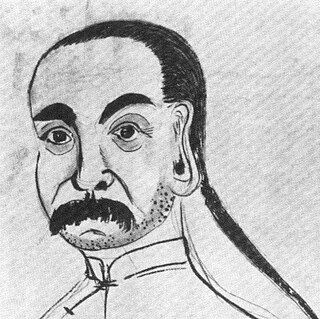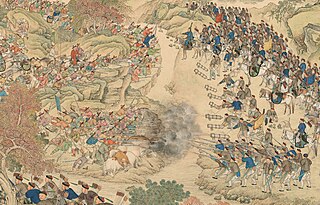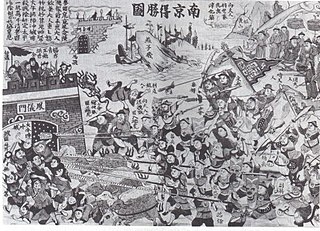 W
WThe Boxer Rebellion, Boxer Uprising or Yihetuan Movement, was an armed insurrection in China between 1899 and 1901, towards the end of the Qing dynasty. It was initiated against the increasing foreign intervention including Christian missionary work in the country, by the Militia United in Righteousness (Yìhéquán), known in English as the Boxers because many of their members had practised Chinese martial arts, also referred to in the Western world at the time as Chinese Boxing.
 W
WThe Dungan Revolt (1862–1877) or Tongzhi Hui Revolt or Hui (Muslim) Minorities War was a war fought in 19th-century western China, mostly during the reign of the Tongzhi Emperor of the Qing dynasty. The term sometimes includes the Panthay Rebellion in Yunnan, which occurred during the same period. However, this article relates specifically to the uprising by members of the Muslim Hui and other Muslim ethnic groups in China's Shaanxi, Gansu and Ningxia provinces, as well as in Xinjiang, between 1862 and 1877.
 W
WThe Dungan revolt (1895–1896) was a rebellion of various Chinese Muslim ethnic groups in Qinghai and Gansu against the Qing dynasty, that originated because of a violent dispute between two Sufi orders of the same sect. The Wahhabi inspired Yihewani organization then joined in and encouraged the revolt, which was crushed by loyalist Muslims.
 W
WThe Eight Trigrams uprising of 1813 broke out in China under the Qing dynasty. The rebellion was started by some elements of the millenarian Tianli Sect (天理教) or Heavenly Principle Sect, which was a branch of the White Lotus Sect. Led by Lin Qing and Li Wencheng, the revolt occurred in the Zhili, Shandong, and Henan provinces of China.
 W
WIn the Jahriyya revolt of 1781 sectarian violence between two suborders of the Naqshbandi Sufis, the Jahriyya Sufi Muslims and their rivals, the Khafiyya Sufi Muslims, led to Qing intervention to stop the fighting between the two, which in turn led to a Jahriyya Sufi Muslim rebellion which the Qing dynasty of China crushed with the help of the Khufiyya (Khafiyya) Sufi Muslims.
 W
WThe Lin Shuangwen rebellion occurred in 1787–1788 in Taiwan under the rule of the Qing dynasty. It was initiated by Lin Shuangwen, but was quelled by the Qianlong Emperor. Lin Shuangwen was subsequently executed.
 W
WThe Miao Rebellion of 1795–1806 was an anti-Qing uprising in Hunan and Guizhou provinces, during the reign of the Jiaqing Emperor. It was catalyzed by tensions between local populations and Han Chinese immigrants. Bloodily suppressed, it served as the antecedent to the much larger uprising of Miao Rebellion (1854–73).
 W
WThe Nian Rebellion was an armed uprising that took place in northern China from 1851 to 1868, contemporaneously with Taiping Rebellion (1851–1864) in South China. The rebellion failed to topple the Qing dynasty, but caused immense economic devastation and loss of life that became major long-term factors in the collapse of the Qing regime in the early 20th century.
 W
WThe Red Turban Rebellion of 1854–1856 was a rebellion by members of the Tiandihui or Heaven and Earth Society (天地會) in the Guangdong province of South China.
 W
WThe Revolt of the Altishahr Khojas was an uprising against the Qing dynasty of China, which broke out in 1757 during the reign of the Qianlong Emperor. The rebels were led by Khwāja-i Jahān, leader of the White Mountain Sufis. Qing era documents refer to the event as the "Pacification of the Muslim regions". Hojijan and his brother, Burhān al-Dīn, both held the Muslim title Khoja.
 W
WThe Revolt of the Three Feudatories, also known as the Rebellion of Wu Sangui, was a rebellion in China lasting from 1673 to 1681, during the early reign of the Kangxi Emperor of the Qing dynasty (1644–1912). The revolt was led by the three lords of the fiefdoms in Yunnan, Guangdong and Fujian provinces against the Qing central government. These hereditary titles had been given to prominent Han Chinese defectors who had helped the Manchu conquer China during the transition from Ming to Qing. The feudatories were supported by Zheng Jing's Kingdom of Tungning in Taiwan, which sent forces to invade Mainland China. Additionally, minor Han military figures, such as Wang Fuchen and the Chahar Mongols, also revolted against Qing rule. After the last remaining Han resistance had been put down, the former princely titles were abolished.
 W
WThe Taiping Heavenly Kingdom, later shortened to Heavenly Kingdom or Heavenly Dynasty, was an unrecognized oppositional state in China and Chinese Christian theocratic absolute monarchy from 1851 to 1864, supporting the overthrow of the Qing dynasty by Hong Xiuquan and his followers. The unsuccessful war it waged against the Qing is known as the Taiping Rebellion. Its capital was at Tianjing.
 W
WThe Taiping Rebellion, also known as the Taiping Civil War or the Taiping Revolution, was a massive rebellion or civil war that was waged in China between the Manchu Qing dynasty and the Han, Hakka-led Taiping Heavenly Kingdom. It lasted from 1850 to 1864, although following the fall of Nanjing the last rebel army was not wiped out until 1871. After fighting the bloodiest civil war in world history, with 30 to 50 million dead, the established Qing government won decisively, although the outcome is considered a pyrrhic victory.
 W
WThe Third Battle of Nanking was the last major engagement of the Taiping Rebellion, occurring in 1864 after the death of the king of the Taiping Heavenly Kingdom, Hong Xiuquan. There were probably more than a million troops in the battle. Zeng Guofan claimed that the Taiping army sustained 100,000 dead in the three-day clash. Nanking had been the capital of the Heavenly Kingdom and was known by the Taipings as Tianjing. This battle was the effective end of the Taiping army and Nanking was the last major Taiping city to fall back under Imperial control.
 W
WXinhai Lhasa turmoil refers to the ethnic clash in the Lhasa region of Tibet and various mutinies following the Wuchang Uprising. It effectively resulted in the end of Qing rule in Tibet.